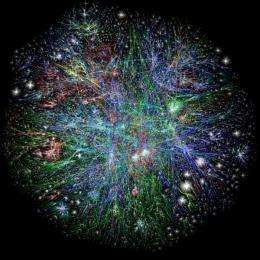January 14, 2009 feature
Internet Growth Follows Moore's Law Too

(PhysOrg.com) -- Originally, Moore’s Law described the number of transistors that can fit on an integrated circuit, which doubles approximately every 18 months. Now, a team of researchers from China has discovered that Moore’s Law can also describe the growth of the Internet. In a recent study, the researchers have predicted that the Internet will double in size every 5.32 years.
That finding is one of several results from the study published by Guo-Qing Zhang, et al., in a recent issue of the New Journal of Physics. The researchers investigated the evolution of large-scale Internet topology, or how the Internet is structured and connected. Based on routing data of six-month intervals from December 2001 to December 2006, the researchers predicted not only the Internet’s exponential growth rate which follows Moore’s Law, but also more specifically how the Internet evolves.
The study looked at the Internet not in terms of Web sites in the World Wide Web, but at the level of autonomous systems (AS). As Zhang explained, an AS, the unit of routing policy, is an administrative routing domain that can apply its own policy, which is a result of a mutual commercial agreement between autonomous systems. A university, an ISP, or a large company network can own an AS.
In the researchers’ model, each node represents an autonomous system. A link between two autonomous systems is, in the real world, both physical (i.e. optical fiber cables connecting the two networks) and commercial (i.e. an agreement between the two networks).
To identify the core of the Internet, which is the most important part, the researchers used a method called k-core decomposition. Here, a k-core is gained by recursively removing all nodes (with their respective links) with degree less than k. Very few nodes belong to the core: the most central part of the core (the nucleus) contains less than 0.3% of the total nodes.
Overall, the researchers found that the Internet’s core and the periphery seem to be governed by different evolutionary mechanisms. While the core is relatively stable, the majority of the new nodes and edges that contribute to the explosion of the Internet appear in the periphery. This result contrasts with previous studies, which have shown that the maximum k of the core increases as the size of the full Internet increases.
“Many models are proposed to predict the evolutionary properties of the Internet in the future, and to our knowledge, these models assume that the central part and the periphery obey the same evolving mechanism, and the maximal connectivity of the Internet should grow very fast,” Zhang, of the Institute of Computing Technology at the Chinese Academy of Sciences, told PhysOrg.com. “Here we show that the maximal degree (connectivity number) as well as the size of the central part is relatively stable, and the explosion is mainly contributed by the periphery. These findings indicate a completely different picture against the previous works, and can be considered as important criteria for modeling the Internet.”
The most accurate model to describe the Internet evolution may be the so-called positive-feedback preference model. Here, a node’s number of links increases as a feedback loop of the node’s degree. However, the researchers explain that some other hidden mechanism must exist to explain why the maximum k remains stable.
The results also showed that the Internet overall is more loosely connected than previously thought. That is, although there is a high density of links connecting to the large-degree nodes (the “rich-club phenomenon”), connections between large-degree nodes are relatively sparser than the expected number, given their degrees. Instead, the results showed an unexpectedly high number of links connecting small-degree nodes, making the Internet more spread out than previously thought.
As the scientists explained, understanding a network’s topology is a crucial prerequisite for optimizing its performance. They hope that these results will help lead to an overall model of the Internet.
“Understanding the Internet topology is crucial for the design of routing protocol, P2P traffic optimization, as well as the design of some intelligent strategies against the congestion and cascading failure,” said co-author Tao Zhou of the University of Science and Technology of China and the University of Fribourg.
More information: Zhang, Guo-Qing; Zhang, Guo-Qiang; Yang, Qing-Feng; Cheng, Su-Qi; and Zhou, Tao. “Evolution of the Internet and its Cores.” New Journal of Physics 10 (2008) 123027.
Copyright 2008 PhysOrg.com.
All rights reserved. This material may not be published, broadcast, rewritten or redistributed in whole or part without the express written permission of PhysOrg.com.





















